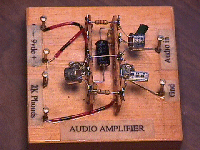
I enjoy building QRP (low power) ham radio equipment from scratch.
Since I am never willing to pay big bucks for metal chassis readily available
on the market, I build my radios in unusual containers-- in fact that
is my trademark in my hometown and local Ham Radio Club. When I am
ready to build another radio, I take a stroll through Wal-Mart to look
for pans and other metal containers that are begging to be turned into
radio equipment. Below, enjoy a view of more of my HOMEBREW QRP RADIO COLLECTION:
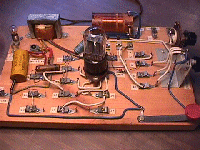
This is an electronic breadboard which I found at an antique store in 1998. Many circuits
can be built on this board. Wire connections are made with Fahnestock Clips. It
looks like this board has been tailored for building radio circuits. There is a
Morse Code key for sending CW at the lower right. The tube is a 6SN7.
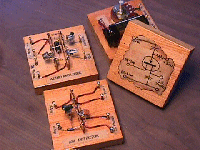
This summer (1999), I built some breadboard modules for experimenting. A specialized
circuit is built on each board; an audio amplifier, a DC power supply, a voltage-doubler
crystal detector, an AM detector, etc. Each board is terminated with brass nails for all
external connection.

These boards were built to do experimenting with crystal detectors. I can test
different detectors by switching in and out each module. The modules are connected
to each other using alligator clips. I would like to build the ultimate crystal receiver
and this, I feel, is the best way to experiment with differnet circuits. It's fast and
convenient.
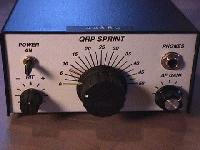
This 30 Meter (10 MHz) transceiver was built from a kit. The QRP SPRINT uses a direct conversion receiver and delivers about 2 Watts of transmitting RF. This is a CW (morse code) transceiver only, since the 30 Meter band is only a CW band. I have made several contacts using this radio.
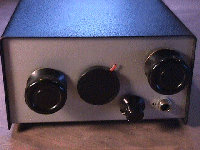
This is a homebrew 30 Meter (10 MHz) receiver. This receiver was built from scratch from a QST article. The 30 Meter band lends itself to QRP homebrewing quite well; the radio equipment can be easily built, there are many other homebrew radios being used on this band by other amateurs, and many of the signals on this band are QRP so there is no need to compete with super stations.
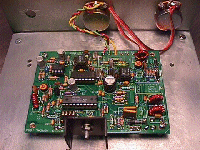
Yet, another 30 Meter transceiver kit. This is the famous 38 Special. This transceiver
consists of a superheterodyn receiver and a 300 mW (1/3 Watt) transmitter. I have had a lot
of fun with this transceiver. One day, I modified the transmitter according to the instructions
for 5 Watts output. When I tested the transmitter, the final amplifier went into self
oscillation and the final FET launched itself and hit the ceiling. I never did find the
transistor.
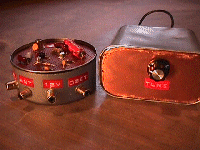
This is another rare view of the Tuna Tin transmitter and its matching VFO which is
built in a Spam can. This transmitter was built from the May, 1976 QST article. This
is a 40 Meter (7 MHz) CW transmitter and it delivers 300 mW (1/3 Watt).
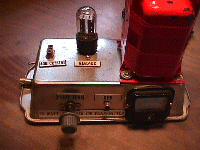
This is a 40 Meter (7 MHz) "Gaseous Transmitter". The circuit used here is the
popular 1950's 6L6 transmitter. I built mine into an inverted bread pan. This transmitter
will deliver about 25 Watts output in the CW portion of 40 Meters. I built this radio in
1991 when I was in college. Haven't put it on the air since the early 1990's.
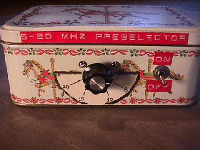
This is an HF Preselector for a shortwave receiver. I found the circuit for this in a
1970's electronic magazine; I cannot remember exactly which magazine it was. This project
was built in 1991 while I was in college. I needed a preselector for my shortwave receiver
to help eliminate the images created by the stronger broadcast stations.
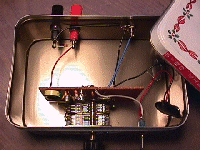
Like the case? At the time, I refused to pay large amounts of cash for a chassis
from Radio Shack. I was in college and lived on a very small budget.
So, I visited the Dollar Store in the mall in Sault St. Marie, Michigan, and found
this wonderful metal box for $1. The size was perfect for the project. This project
is what created my interest in building radio equipement in exotic containers. As you can see,
this was built in December.
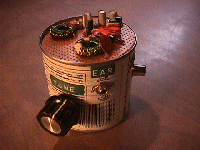
I put this receiver together in one evening. In 1996, the local Ham Radio Club (the HARA
in Marquette, Michigan) was going to have a homebrew presentation after the monthly meeting.
I decided to build a receiver for the meeting. That evening, we ate spaghetti for dinner so
I recycled the mushroom can for my project. The receiver is a 40 Meter (7 MHz) direct conversion
using a simple diode mixer. The receiver does work! It doesn't take much more than just
an imagination to built working amateur radio gear.
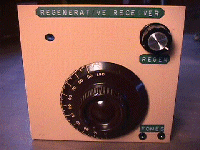
This is my very first Regenerative Receiver project, which I built in 1996. The chassis
is built from copper clad circuit board. The circuit is a simple 1 tube receiver using the #30
tube which was featured in the 1930's. This reciever does work, but there is not much audio
drive.
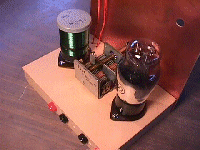
When listening to this radio, you must be in an absolutely quiet room since the circuit
is a regenerative detector only-- there is no audio amplification in this circuit.
I made two coils for this receiver; one for the top of the AM broadcast band and the other
for the 80 Meter amateur radio band. The coils are wound on empty film canisters.
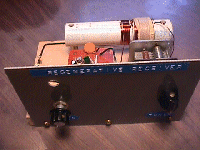
This is a solid state regenerative receiver for the AM broadcast band. The receiver is built on a pine board and the front panel is a piece of copper clad circuit board. I wound the coil on a piece of PVC pipe. This receiver works quite well.